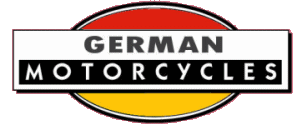



A Brief History of the Marque
Lutz-GmbH, Braunschweig-Kralenriede, Bienroder Weg 53, Fernruf 22122
Lutz was a small manufacturer which had been building stationary engines since 1948.
Otto Lutz held an engineering doctorate and had been employed as a professor at the Technical University in Stuttgart (1936) and later at the German Aircraft Engine Research Institute in Braunschweig.
He developed an efficient bicycle engine which could be easily installed in any existing bicycle frame. The engine was a 58cc 2-stroke as authorities limited new designs to less than 60cc.
The engine was also used to power wheel-chairs, lawn mowers, pumps and all manner of stationary machines.
Other firms including Goebel and Delius used this engine.
Lutz developed several motor scooters, examples of which competed in the ADAC Deutschland Rundfahrt reliability trial. Lutz also built and marketed a moped. The first scooters appeared in 1949 and were of very basic construction, rather similar to the early Italian machines. Some 2000 of these 48cc (b/s 40/39.5mm 49.3 cc) machines were sold in 1951. The following year Lutz produced a larger scooter with a 175cc engine, designed by W. Lieb. It was similar in appearance and retained the two-speed gearbox of the smaller model.
Professor Lutz apparently left the company in the hands of a manager whilst he focused on other areas of interest. In 1954 the company ran into financial difficulties and was declared bankrupt.
Lutz was later acknowledged for the work he had done relating to jet engines and two-stroke engine technology, and became a respected figure in aviation research. He died in 1974 and his personal Lutz P53 became part of the Städtisches Museum Braunschweig collection.
Le moteur LUTZ (cycle 2 temps) n'a qu'une cylindrée de 58 cm3, une course et un alésage de 43 cm., donnant une puissance de 1,25 CV.
Le piston est plat. L'admission se fait directement dans le carter par une soupape à diaphragme, assurant le refroidisse- ment et le graissage continuel de l'embiellage.
Le moteur est monté d'un carburateur Pallas à boisseau. La transmission se fait par chaine. L'allumage est assuré par un volant magnétique Bosch.
La vitesse maximum de ce moteur est de 35 km. à l'heure. Il permettrait de monter des côtes de 16 %, sans pédalage, à la vitesse de 10 km. à l'heure.
Signalons la facilité de montage de ce moteur sur n'importe quelle bicyclette. (Fig. b.)
The LUTZ engine (2-stroke cycle) only has a displacement of 58 cm3, a stroke and bore of 43 cm., producing 1.25 HP.
The piston is flat. Admission is made directly into the crankcase by a diaphragm valve, ensuring cooling and continuous lubrication of the crankshaft.
The engine is fitted with a Pallas bushel carburetor. Transmission is by chain. Ignition is ensured by a Bosch magnetic flywheel.
The maximum speed of this engine is 35 km. per hour. It would allow you to climb hills of 16%, without pedaling, at a speed of 10 km. per hour.
Let us point out the ease of assembly of this engine on any bicycle. (Fig. b.)
Sources: François-Marie Dumas, zabytkowemotocykleirowery.pl, de.wikidpedia.org, et al.
If you have a query or information about Lutz machines, please contact us